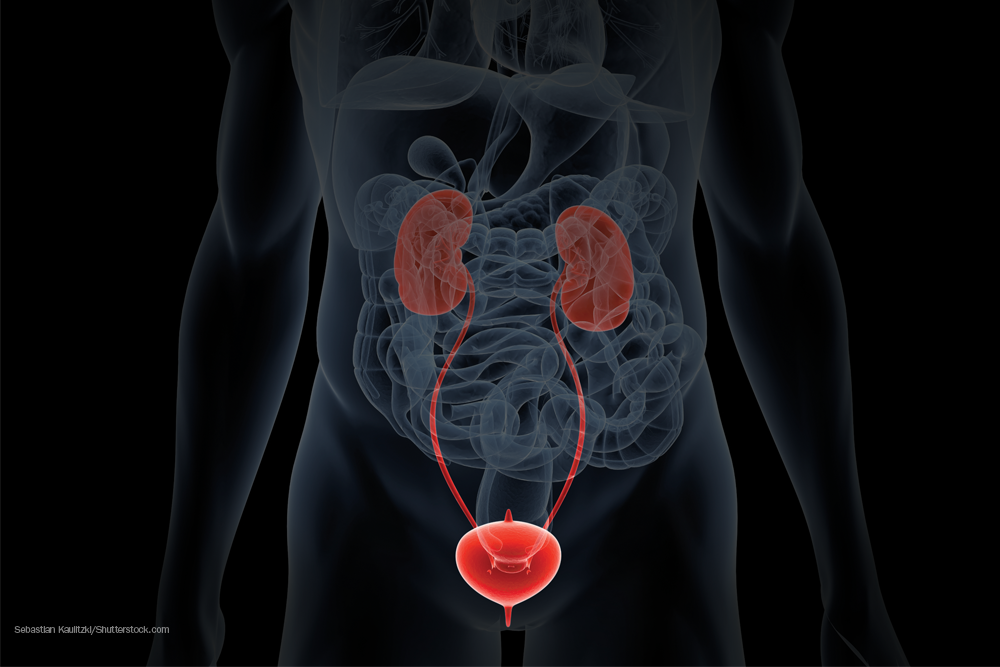Balversa Fast-Tracked for Bladder Cancer
Erdafitinib is first targeted therapy for FGFR3 or FGFR2 genetic alteration.

The Food and Drug Administration granted accelerated approval to erdafitinib (BALVERSA, Janssen Pharmaceutical Companies) for patients with locally advanced or metastatic urothelial carcinoma, with susceptible FGFR3 or FGFR2 genetic alterations, that has progressed during or following platinum-containing chemotherapy, including within 12 months of neoadjuvant or adjuvant platinum-containing chemotherapy. Janssen has selected US Bioservices to dispense the drug.
Patients should be screened using an FDA-approved companion diagnostic for erdafitinib: The FDA also approved the therascreen FGFR RGQ RT-PCR Kit, developed by QIAGEN, for use as a companion diagnostic for this therapeutic indication.
Erdafitinib approval was based on data from a cohort of 87 patients enrolled on Study BLC2001 (NCT02365597), a multicenter, open-label, single-arm trial. These patients had locally advanced or metastatic urothelial carcinoma that had progressed on or after at least one prior chemotherapy and had certain FGFR3 gene mutations or FGFR2 or FGFR3 gene fusions. Patients received erdafitinib at a starting dose of 8 mg once daily with a dose increase to 9 mg daily in those whose serum phosphate levels were below the target of 5.5 mg/dL, between days 14 and 17. The starting dose was increased to 9 mg daily in 41% of the patients. Erdafitinib was administered until disease progression or unacceptable toxicity.
Trending: Rise In Global Travel Fuels Business Opportunities
“We’re in an era of more personalized or precision medicine, and the ability to target cancer treatment to a patient’s specific genetic mutation or biomarker is becoming the standard, with advances being made in new disease types. Today’s approval represents the first personalized treatment targeting susceptible FGFR genetic alterations for patients with metastatic bladder cancer,” said Richard Pazdur, M.D., director of the FDA’s Oncology Center of Excellence and acting director of the Office of Hematology and Oncology Products in the FDA’s Center for Drug Evaluation and Research. “FGFRs regulate important biological processes including cell growth and division during development and tissue repair. This drug works by targeting genetic alterations in FGFRs.”
The most common type of bladder cancer is transitional cell carcinoma, also called urothelial carcinoma. Bladder cancers are associated with genetic mutations that are present in the patient's bladder or entire urothelium (the lining of the lower urinary tract). Bladder cancer is the sixth most common cancer in the United States. Fibroblast growth factor (FGFR) alterations are present in approximately one in five patients with recurrent and refractory bladder cancer. In 2018, an estimated 81,190 new cases of bladder cancer are expected, resulting in 17,240 deaths, and the five-year survival rate is 5%, according to New Jersey-based Johnson & Johnson, parent company of Janssen
“For patients diagnosed with urothelial cancer, outcomes are unfortunately disheartening due to the aggressiveness of the disease,” said Peter Lebowitz, MD, PhD, Global Therapeutic Area Head, Oncology, Janssen Research & Development, LLC. “Through the continued development of erdafitinib, and working closely with the FDA, we look forward to bringing a potential new treatment option to patients.”
Urothelial cancer, also known as transitional cell cancer, is the sixth most common type of cancer in the U.S. These cancers start in the urothelial cells that line the inside of the bladder. In 2018, an estimated 81,190 new cases of bladder cancer are expected, resulting in 17,240 deaths.4 For patients with metastatic disease, outcomes can be dire due to the often rapid progression of the tumor and the lack of efficacious treatments, especially in relapsed or refractory disease. The relative five-year survival rate for patients with metastatic disease is five percent.
Recent News: NHA Launches Learning Resource for Pharm Techs
The major efficacy outcome measure was objective response rate (ORR) as determined by blinded independent review committee according to RECIST 1.1. ORR was 32.2% (95% CI:22.4, 42.0), with complete responses in 2.3% and partial responses in 29.9%. Median response duration was 5.4 months (95% CI: 4.2, 6.9). Responders included patients who had previously not responded to anti PD-L1 or PD-1 treatment.
Erdafitinib can cause ocular disorders. Central serous retinopathy or retinal pigment epithelial detachment resulting in visual field defect was reported in 25% of patients. The most common adverse reactions reported in at least 40% of patients were increased serum phosphate, stomatitis, fatigue, increased serum creatinine, diarrhea, dry mouth, onycholysis, increased alanine aminotransferase, increased alkaline phosphatase, and decreased sodium.
The recommended initial dose of erdafitinib is 8 mg orally once daily (with or without food) with a dose increase to 9 mg daily if criteria are met.